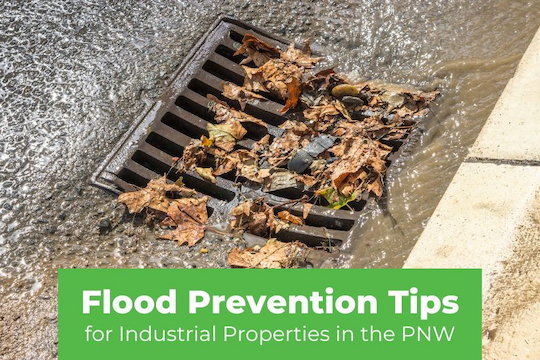Stormwater management is an essential concern for Homeowners’ Associations (HOAs) nationwide. HOAs act as the stewards responsible for protecting and maintaining managed communities and often find themselves dealing with the challenges of common stormwater-related issues.
Improperly managed stormwater can wreak havoc in many ways, and the following covers the most common issues while offering a few tips on addressing them to make the community safer and more resilient for residents and the surrounding environment.
Understanding HOA Stormwater Management

In basic terms, stormwater management involves controlling the water from rainstorms and snow melt so that it does not damage or erode the HOA-managed property. While this sounds straightforward, in practice, especially in densely populated areas, stormwater runoff is difficult to manage and presents many challenges.
When rainfall lands on concrete and other impervious surfaces like rooftops and roads, it does not get absorbed into the earth. Instead, it runs off and accumulates in low areas of the property’s landscape, potentially causing problems. Understanding this fundamental issue holds the key to solving common problems. The solutions all involve controlling and directing the stormwater more efficiently and effectively.
Identifying Common Issues
Stormwater can cause several headaches for HOAs, but flooding is usually the most obvious because it leaves visible property damage behind. Erosion and impacted water quality are other common issues. The following points cover a variety of problems that arise due to stormwater and some ways that HOAs can tackle them.
Flooding and Erosion
Flooding can happen in any community, but it becomes especially problematic in hilly developments. During severe rainstorms, large amounts of runoff can overwhelm the drainage systems at the low points of the community’s land, exacerbated by vegetation, garbage, and other debris washed down the hills along with the rainwater.
The runoff, along with the pull of gravity, can cause erosion in many parts of the neighborhood. The migration and loss of soil can contribute to falling trees and weakening infrastructure, affecting home foundations, roads, and more.

Upgrading the community’s drainage system to handle a heavier volume of water can reduce the chances of flooding. Regular maintenance and cleanouts can keep storm drains open and flowing freely, allowing water to move unimpeded from the property. To control erosion, consider using silt fences and terracing on slopes to stop the downward flow of soil, branches, and vegetation.
Water Quality and Built-Up Sediment
During and after rainstorms, water flowing from roads, driveways, and parking lots carries oil, hydrocarbons, and other substances directly into local creeks and other water bodies. Aside from filtering out some types of debris, the stormwater does not receive any additional cleaning or treatment before it enters local waterways.
Over time, stormwater carries sediment off the property and into detention ponds and storm drains. Without regular maintenance and cleaning, the sediment buildup causes these system components to fail and results in flooding.
HOAs can upgrade or install stormwater filtration systems and schedule regular dredging for detention ponds to restore their ability to capture and control stormwater. Additionally, communication and outreach programs can help the HOA educate residents and promote responsible vehicle maintenance to reduce the amount of surface oil and other pollutants.
Blocked Drains and Infrastructure Damage

Blocked drains not only lead to flooding; they can also contribute to damage on roads within the HOA that were not designed to handle large volumes of stormwater. The blockages can allow water to pool and stand for hours, which lets it seep underneath asphalt, lifting edges and deepening potholes and cracks.
HOAs can invest in proper grading and paving of roads to accommodate stormwater flow and prevent related damage. Regular storm drain maintenance can prevent pooling water by keeping drains clear and free-flowing.
Costly Maintenance and Landscaping Issues
HOA stormwater management can become costly, especially if the community’s system needs upgrades or repairs. However, property damage from poorly managed stormwater can become much more costly and continue with every storm.
Adding or improving the community’s green infrastructure is a practical approach to this issue. Green infrastructure such as vegetated swales, rain gardens, and permeable surfaces provide ways to naturally and effectively manage stormwater. Additionally, an HOA stormwater management plan that includes a budget for ongoing maintenance can reduce the more expensive costs of emergency services and repairs to the system after heavy rains.
Poor Planning and Compliance Issues
Poor planning can put your community at a disadvantage in terms of managing stormwater. Systems that need the proper devices, such as an adequate number of well-placed drains, retention ponds, erosion-control devices, and permeable surfaces, have an increased risk of ongoing problems due to poorly managed stormwater runoff.
HOAs also have a responsibility to comply with local, state, and federal regulations in terms of stormwater control. Regulatory entities often require HOAs to develop and implement a detailed stormwater management plan. The HOA may also have to adhere to specific criteria for the design and maintenance of retention basins and other stormwater management devices. Depending on the community’s location and size, it may need specific permits for stormwater discharges and may also need to submit reports regarding HOA stormwater management procedures and follow-through.
Storm Water Management Doesn't Have to be a Problem
Managing stormwater in HOAs is a vital function to maintain not only the community’s well-being but also the integrity of its natural surroundings. By understanding the issues, the importance of stormwater management and system maintenance, and the potential consequences of poor management, HOAs can create a more eco-friendly, safer, and resilient environment for their residents.
When it comes to performing regular maintenance, understanding critical regulatory issues, and other system-related tasks, Catch All Environmental has got you covered. Our team of experts provides economical and efficient solutions to your stormwater-related woes so you can put your system management on auto-pilot. Call Catch All for more information today!













